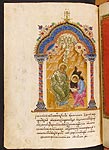Tetraevangelion.
1507. Moscow. Scribe: Nikon. Scribe in Gold: Mikhail Medovartsev. Artist: Feodosy, son of Dionysius
F (272 x 202). 381 leaves.
paper. Ink, cinnabar, colours, gold.
It is written in a calligraphic semi-uncial hand.
The illumination of the manuscript includes four portraits of the Evangelists painted by Feodosy, the son of Dionysius; they are glued on folios 10v, 108v, 171v, 271v. Protective cloth curtains are placed before folios 11r, 11v, 109v, 172r, 172v, 272r, 272v. There are large head-pieces, below them are the traditional symbol of the Evangelits (fols. 12r, 110r, 173r, 273r). Folios 3r, 5r, 104r, 166r, 341r have small head-pieces in the New Byzantine style. Small head-pieces are executed in the Early Printed style (fols 105v and 267r), with geometric and vegetal-geometric motifs (fols. 168v, 266v, 358r). The picture on folio 371r shows the hand with a Calvary cross within the ornanented circle (colours, gold). Rosettes in blue, green, crimson paints with use of gold are illuminated in margins of folios 374r and 376v. The Gospel contains initials in the New Byzantine style in colours and gold (fols. 12r, 110r, 173r and 273r), initials in blue paint and gold (fols. 372-381). Folios 273r has a heading in blue paint, the text is written in gold.
Folio 370v bears the scribe's inscription stating that the manuscript was created in 1507 in Moscow at the Monastery of Nikola the Old during the reign of Grand Duke Vasili III, by request of Ivan Tretyakov. The record names the scribe, gold painter and painter.
The Gospel is one of the most luxurious manuscripts, produced in Moscow during the first third of the 16th century. The codex was commissioned by Ivan Tretyakov, who held high posts at court of Grand Duke: at first he was a printer, then the treasurer of Vasili III, and during of Ivan the Terrible's coronation in 1547, he provided an escort for tsar's regalia to the Assumption Cathedral. At the end of his life he became a monk at the Kirillo-Belozersky Monastery.
The place of origin of the Gospel was a "cell" to the organizer and the head of the Metropolitan and Grand Duke's court scriptorium Mikhail Medovartsev at the Monastery of Nikola the Old near the Moscow Kremlin. He occupied it from the late 15th century and during the first third of the 16th century. A majority of the best Moscow manuscripts were created in this cell during the period of Dionysius, an outstanding artist of the late 15th - early 16th century.
In 1852 the manuscript came into the Imperial Public Library along with the other contents of the Mikhail Pogodin's collection.
Shelfmark: –Õ¡. œÓ„Ó‰. 133.





